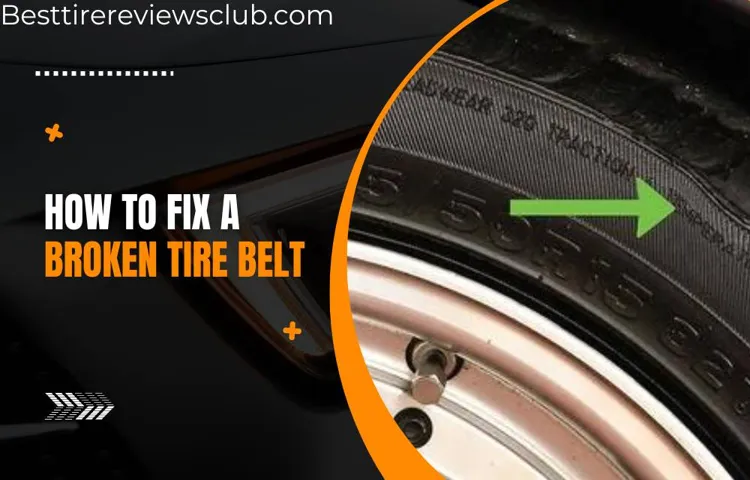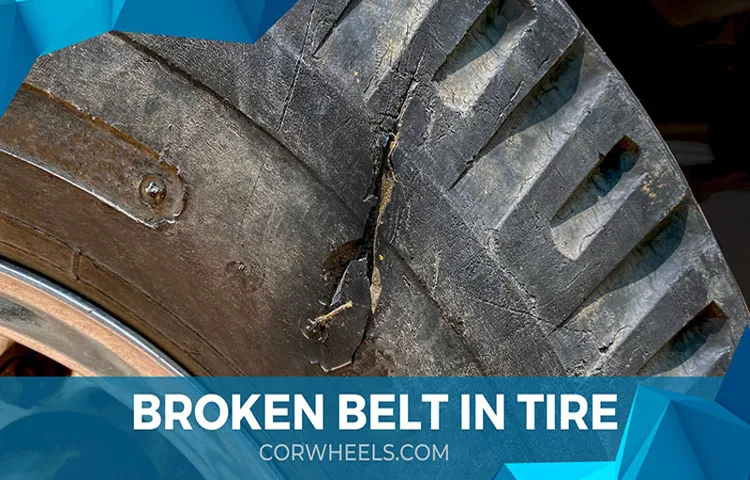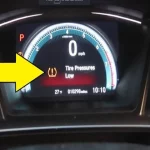Have you ever noticed a wobbling or shaking sensation while driving your car? It could be a sign of several issues, one of which is a broken tire belt. The tire belt is a vital part of your tire that provides stability and durability to the tire’s structure. A broken tire belt can lead to unsafe driving conditions and even accidents.
So, if you want to ensure your safety while on the road, it’s crucial to know how to tell if your tire belt is broken. In this blog post, we’ll discuss the signs to look out for and what to do if you suspect a broken tire belt. So, let’s get started!
Table of Contents
Visual Inspection
If you suspect that the belt in your tire is broken, it’s important to perform a visual inspection to confirm your suspicions. The most obvious sign of a broken tire belt is bulging or blistering on the tire’s surface, indicating that the internal structure is compromised. You may also notice uneven wear on the tire, and the vehicle may pull to one side while driving.
Check for any cracks in the tire sidewall or tread, as this could be another clue that the belt is broken. Another symptom of a broken tire belt is vibration while driving, which can make steering difficult and cause the car to wobble. If any of these signs are present, it’s important to have your tires inspected by a professional mechanic as soon as possible to avoid any potential safety risks on the road.
Cracks in Sidewall
When it comes to visual inspection of your car tires, one crucial aspect to check is the sidewall. This is the area of the tire that runs between the tread and the bead, and it supports the weight of your car. If you notice cracks in the sidewall, it’s a sign that your tires are becoming worn out and may need to be replaced.
These cracks can occur due to a variety of reasons, such as exposure to weather extremes, high temperatures, or prolonged use. It’s essential to monitor your sidewalls regularly and look for any visible signs of damage or wear. One way to do this is to run your fingers along the sidewall and feel for any abnormalities.
Don’t overlook these small details, as they could potentially save you from experiencing a blowout or other tire-related mishap on the road. So, when was the last time you checked your tires’ sidewalls?

Bulges in Sidewall
When it comes to a visual inspection of your tires, one thing you must keep an eye out for is bulges in the sidewall. These bulges can indicate weak spots or damage in the tire, which could lead to a blowout while you are driving. They may be caused by hitting a curb or pothole, underinflation, or overloading the vehicle beyond its weight capacity.
It’s important to address this issue right away to avoid any potential dangerous situations on the road. So, next time you give your tires a once-over, make sure to keep an eye out for any bulges in the sidewall, and if you do find any, bring it to the attention of a professional mechanic. Safety should always be a top priority when it comes to your vehicle, and taking care of issues like this can help ensure that you and your passengers stay safe on the road.
Irregular Wear Patterns
“Irregular Wear Patterns” Subheading keyword: “Visual Inspection” Regular visual inspections are essential in identifying and managing irregular wear patterns. These wear patterns may appear as cupping, feathering, or shoulder wear. Cupping is characterized by curved wear in the center of the tire, making it appear as if it has been scooped out.
Feathering occurs when the tire’s edges are worn out more than the center, giving it a jagged appearance. Shoulder wear happens when the tire’s shoulders are more worn out than the center, and the tire is oval in shape. These wear patterns may be caused by several factors like incorrect tire pressure, misaligned wheels, worn-out suspension components, and driving habits.
Therefore, it’s essential to conduct regular visual inspections to keep track of any irregular wear patterns. Addressing these issues promptly can help prevent more significant problems and even with replacing the tire and potential accidents.
Tire Noise
If you’re experiencing a humming or thumping sound coming from your tires, it could be a sign that the tire belt is broken. The tire belt serves as an internal reinforcement layer that keeps the tire’s shape and helps it retain traction on the road. When the belt is broken, it can cause uneven wear on the tire, leading to the formation of bald spots or bulges.
These irregularities in the tire’s surface can cause the vehicle to vibrate or make noise while driving. To check if the tire belt is broken, you can visually inspect the tire for any bulges or uneven patches. Additionally, you can run your hand along the surface of the tire to check for any abnormalities.
If you notice any issues with your tire, it’s crucial to get it inspected by a professional mechanic as soon as possible. A damaged tire can compromise your vehicle’s safety and cause further damage to the wheelbase if left unattended.
Squealing Sounds
If you’ve been hearing a squealing sound when driving, it’s possible it could be coming from your tires. Tire noise can be caused by a variety of factors, but one of the most common is worn-out tread. As the tread on your tires wears down, it can create a squealing sound, especially when turning.
Other possible causes of tire noise include incorrect tire pressure, misalignment, or even a faulty wheel bearing. It’s important to address any tire noise promptly, as it could be an indication of a bigger issue with your vehicle. Plus, a noisy ride can be annoying and distracting, making driving less enjoyable.
Next time you’re behind the wheel and hear that pesky squealing sound, make sure to have your tires checked out by a professional.
Thumping or Bumping Sounds
Have you ever noticed your car making thumping or bumping sounds? Tire noise is a common culprit, especially for vehicles with worn out or unbalanced tires. When your tires are unbalanced, they don’t rotate evenly, causing an uneven distribution of weight and an unsmooth ride. This can result in a variety of noises, including thumping and bumping sounds.
Moreover, worn-out tires are also more susceptible to producing these sounds, so it’s essential to keep an eye on your tire treads and replace them when needed. In addition to tire noise, high speed can also cause thumping sounds, as the air passing through the tire can create a humming or buzzing noise. Proper tire maintenance, including regular rotations and replacements, can help keep your ride smooth and quiet.
So next time you hear any strange noises coming from your car, make sure to check your tires, and if needed, take your car in for a tune-up!
Steering and Handling Issues
If you’re experiencing steering and handling issues with your vehicle, it’s possible that your tire belt might be broken. A tire belt is a layer of steel or other strong material that reinforces the tread of the tire and helps it maintain its shape. When a tire belt breaks, it can cause the tire to become misshapen and develop a bulge or bubble.
This can lead to vibration, pulling, and other handling issues. To check for a broken tire belt, visually inspect your tires for any bulges or bubbles on the sidewall or tread. You can also run your fingers along the tread to feel for any irregularities.
If you suspect that you have a broken tire belt, it’s important to replace the affected tire as soon as possible. Driving with a damaged tire is not only dangerous, but it can also cause further damage to your vehicle’s steering and suspension components.
Veering to one Side
When it comes to driving, steering and handling issues are not only inconvenient but can also be dangerous. One common problem that drivers experience is veering to one side. This can happen for a variety of reasons, such as tires being misaligned or unbalanced, or suspension issues.
It’s essential to get your vehicle checked by a professional mechanic as soon as you notice any handling issues. Not only can it potentially cause accidents, but it can also cause uneven tire wear and reduce gas mileage. Think of it like a bicycle with a wobbly wheel; it’s challenging to ride straight and can cause additional problems if not fixed right away.
Don’t put yourself or others in danger and get your steering and handling issues resolved as soon as possible.
Vibration in Steering Wheel
If you’ve ever felt a vibration in your steering wheel while driving, you know it can be a worrisome experience. This issue can have several causes, including unbalanced tires or worn-out suspension components. When your tires are out of balance, it can cause a vibration that can be felt in your steering wheel, especially at higher speeds.
In contrast, worn-out suspension components like ball joints or tie rods can cause your car to pull to one side, leading to an imbalanced feeling in the steering wheel. If you’re experiencing these issues, it’s best to have your vehicle inspected by a professional mechanic. They can diagnose the source of the vibration and provide an effective solution to ensure your safety while driving.
Remember, addressing steering and handling issues early on can prevent costly repairs down the line and keep you driving smoothly on the road.
Consult a Professional Mechanic
If you suspect your tire belt might be broken, it’s important to have it checked out by a professional mechanic. One telltale sign of a broken tire belt is a bumpy ride or vibration while driving. You might also notice a bulge or bubble on the sidewall of the tire, indicating a separation of the tire’s layers.
Another sign could be uneven wear on the tire, particularly in the tread. These signs could indicate a serious issue with your vehicle’s safety and should not be ignored. A professional mechanic will have the expertise and tools necessary to properly diagnose and fix the problem, keeping you safe on the road.
So if you’re experiencing any of these symptoms, don’t hesitate to make an appointment with your local mechanic and get your tires checked out. It can save you from a dangerous situation on the road.
Conclusion
In conclusion, figuring out whether your tire belt is broken is actually pretty simple- just pay attention to the signs. If your car starts to vibrate, pull to one side, or develop bulges or bumps on the surface of the tire, it’s time to get it checked out. And remember, if you ever feel like something’s off with your tires, don’t be a rubber chicken- take action and get them inspected ASAP!”
FAQs
What are the signs of a broken tire belt?
Signs of a broken tire belt include uneven wear on the tire, vibrations while driving, and visible bulges or bumps on the tire.
Can a tire with a broken belt be repaired?
A tire with a broken belt cannot be repaired and must be replaced.
How long do tire belts typically last?
Tire belts can last up to 50,000 miles or more, but their lifespan can be affected by factors such as road conditions and driving habits.
Can a broken tire belt cause a blowout?
Yes, a broken tire belt can cause a blowout if it goes unrepaired and the weakened tire is subjected to excessive stress or pressure.
How can I prevent a tire belt from breaking?
To prevent a tire belt from breaking, you should ensure that your tires are properly inflated, rotate them regularly, and avoid driving over potholes or other road hazards.
Can a tire belt be visually inspected for damage?
Yes, a tire belt can be visually inspected for damage by looking for bulges or bumps on the tire or irregular wear patterns.
How much does it cost to replace a tire with a broken belt?
The cost of replacing a tire with a broken belt can vary depending on the brand and size of the tire, but it typically ranges from $100 to $300 per tire.



